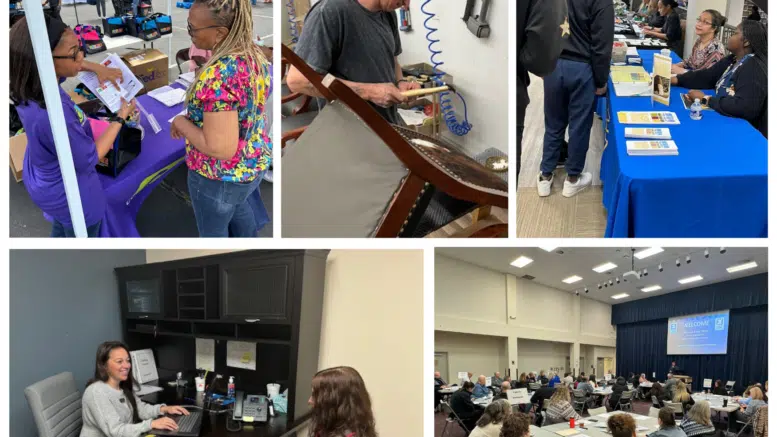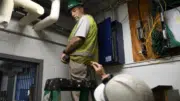By Rachel Crumpler
Danny Hampton started working as a prison chaplain at Marion Correctional Institution in McDowell County in 2010. In the role, he helped advise and guide incarcerated men as they worked to rebuild their lives.
But when they got released, he frequently saw those same men “crashing and burning.”
Hampton said many factors contributed to that but one of the biggest drivers he observed was lack of support.
“Individuals who are coming out of prison have no clue how to navigate getting their own needs met,” he said. “I would have people calling me saying, ‘I don’t know what I’m supposed to do. They told me not to mess up anymore, but I don’t know how not to mess up.’”
Early on, Hampton didn’t have any easy answers. There was no central organization to send someone in the county for reentry support.
In response to this gap, in 2012, Hampton founded Freedom Life, a faith-based nonprofit helping formerly incarcerated people rebuild their lives. Still, resources in the county remained siloed, he said.
But that changed when the McDowell County Reentry Council formed in 2017. A Local Reentry Council is an organized network of individuals, community organizations and agencies that work together to provide formerly incarcerated people with needed resources and services such as housing, transportation, employment, getting signed up for Medicaid, substance use treatment and more.
Freedom Life handles the day-to-day coordination of services for reentry council clients. Other community groups and county stakeholders also contribute to a network of support for this population. McDowell’s reentry council has grown to include over 80 partners, including the local community college, sheriff’s office and chamber of commerce.
Hampton, the reentry council coordinator, said the pooling of resources has made a difference. Now, there’s a clear place to send people leaving incarceration in need of reentry support. Navigating all of the resources becomes much less confusing because of the established partnerships.
In 19 counties across North Carolina, reentry councils are a key force supporting people and facilitating smoother experiences back in the community.
Now more are on the way.
N.C. Department of Adult Correction Secretary Todd Ishee announced last month at the North Carolina Rehabilitation and Reentry Conference that his department is allocating $1.9 million to establish 11 additional Local Reentry Councils to serve 27 more counties — mostly in rural areas.
“It’s critical that we meet people leaving incarceration with the services they need to be successful and avoid returning to prison or jail,” Ishee said in a news release this month. “This funding to support these councils will help build safer communities in North Carolina. It represents a major step forward in our goal to serve all 100 counties with local reentry councils.”
The Department of Commerce also announced last month plans to allocate $750,000 to establish three councils.
The recent investments in additional reentry councils are part of the state’s push to improve reentry support for formerly incarcerated people, an effort driven by Gov. Roy Cooper’s Executive Order No. 303 signed in January. Cooper’s order enrolled North Carolina in Reentry 2030, a national initiative sponsored by the nonprofit Council of State Governments that aims to dramatically improve reentry success. Providing reentry assistance through Local Reentry Councils in every county was one of the goals North Carolina committed to achieving by 2030, and the state will soon be halfway there.
Since 95 percent of the state’s incarcerated population will one day return home, reentry support is particularly critical to help people returning home make more successful transitions into the community.
“People don’t change without help,” Hampton said. “To see the state be far more motivated on a state level as well as a local level to be engaged in helping people change their lives — we’re going to change individuals and families, and we’re going to change communities as well.”
More than a resource list
Last year, 19,458 people were released from N.C. state prisons, according to Department of Adult Correction data, returning to counties all across the state. But walking out of the doors of a prison often marks the start of new hardships and challenges as people work to rebuild their lives. Many people have a long list of needs to tackle — housing, employment, health care, family reunification and more.
Getting those needs met can be a starkly different experience in the 19 counties currently served by reentry councils compared to those without.
Rather than confront a maze of uncertainty about how to address certain needs, reentry councils and the case managers working directly with formerly incarcerated people serve as hubs to resources.
“We have a vested interest in this person,” said Brent Bailey, coordinator of the Buncombe County Reentry Council, which serves about 300 new clients a year. “We want them to be successful. We don’t want them to get out of prison on Monday and be sitting around pulling their hair out on Thursday.”

Reentry case managers offer more than just a piece of paper with a list of resources; they meet one-on-one with formerly incarcerated people to understand and address their specific needs and facilitate connections to care
“I tell people all the time, ‘We’re not giving them a handout but a hand up,’” said Anita Lynch, reentry coordinator of the NEW Reentry Council serving Nash, Edgecombe and Wilson counties.
Marcus Reddrick, coordinator of the Mecklenburg County Reentry Council, said no two days or clients are the same. They tailor their approach with clients based on their needs and goals and there is no cut-off for the length of time they work with clients.
“We are advocates to connect people with services,” Reddrick said. “Sometimes we’re counselors. Sometimes we are motivational speakers. Sometimes we are teachers. We wear a lot of different hats when it comes to being able to help these individuals based on what they need assistance with.”
Reddrick said some people may come in once to be pointed in the direction of employers that are willing to hire people with conviction records. Others remain in communication for months as they work to establish a stable life.
Reddrick’s seen that personalized support make a difference. He’s heard clients say so, too. Last year, the Mecklenburg Reentry Council served 360 clients and, of the clients served, only 7.29 percent were incarcerated again. The recidivism rate has dropped over the years, declining from a 13 percent recidivism rate in 2021.

These metrics are below the state’s recidivism rate, an indication that reentry councils are tools for improving successful outcomes in the community. A report released in April by the North Carolina Sentencing and Policy Advisory Commission found a 44 percent re-arrest rate within two years from a sample of 12,889 people released from North Carolina state prisons in fiscal year 2021. The same sample had an 18 percent re-conviction rate and 33 percent were sent back to prison within two years of their release.
Bailey from Buncombe’s reentry council agreed that councils help improve success in the community. He said the average age of clients served is 40 years old — many with histories of cycling in and out of incarceration.
“We’re getting people that are motivated, not mandated,” Bailey said. “No judge is making them come. There’s no court mandate. They are already motivated and want something different and many times we just kind of bridge the gap.”
Creating resources where none exist
For years, the state’s reentry councils have been concentrated in the state’s urban centers. This year’s expansion of councils focuses on building support in rural communities — areas where resources tend to be sparse.
Hampton helped form the McDowell Reentry Council in the rural county in the foothills with a population of about 45,000 people. He’s also consulting with other rural counties looking to get councils established and said rural reentry councils have to approach their work a bit differently. In addition to coordinating resources, rural councils have to heavily focus on developing resources that don’t exist.
For example, transportation access is one big difference. Urban reentry councils can often provide funds for bus passes so folks can get around, but in rural settings that isn’t an option. To address this need, McDowell’s reentry council created a transport network in which Hampton said volunteers provided over 43,000 miles of rides in 2023 to formerly incarcerated people going to jobs, medical appointments, probation meetings and other destinations.
Additionally, there’s so little housing in the county that the council has purchased tents for folks who end up sleeping in the woods, Hampton said. The McDowell Reentry Council has been hard at work to expand housing options for formerly incarcerated people and in 2022 Hampton said Freedom Life — in partnership with McDowell County and the City of Marion — secured multi-million dollar grant funding to build 44 apartments specifically to provide program housing for men and women released from incarceration.
“You have to pull your resources together to work together to be able to generate the capacity to help people,” Hampton said. “They have to do that in urban areas too. It’s just more intensified in rural communities, where you have far less resource capacity available to you.”

For reentry councils to work best, community buy-in is needed to cultivate a network of support and an environment that fosters second chances.
Hampton’s seen some residents, particularly in rural communities, resist reentry efforts as they think that increased support might bring more crime into the area. But Hampton pushes against that notion, explaining that providing support actually makes communities safer. He argues that tapping into the potential of these justice-involved individuals has community benefits.
The prison system is also making an effort to embed more opportunities for reentry councils to come into prisons so connections can be made ahead of a person’s release.
“When you come out of a facility, and it takes time to find out what you need, there are already many other needs that come around so there can be a vicious cycle,” George Pettigrew, deputy secretary for rehabilitation and reentry at the Department of Adult Correction, told NC Health News. “Getting them ready day one and having those supports ready for them is so key.”
Funding from the N.C. Department of Adult Correction will create the following 11 Local Reentry Councils serving 27 counties:
- Pender, Duplin, Brunswick
- Carteret, Onslow
- Halifax, Northampton
- Lenoir, Greene, Jones
- Avery, Yancey
- Gaston
- Union, Anson
- Chatham, Lee
- Rowan
- Hertford, Gates, Chowan, Bertie
- Washington, Beaufort, Hyde, Tyrrell, Martin
Shawanda Barnes wants everyone to know what it’s like to connect with a Local Reentry Council upon release.
It wasn’t an experience she had initially. Barnes left prison in 2009 determined to never return but with no resources to rebuild her life in the community. She struggled on her own — without family or community support — for years before getting connected in 2014 to the NEW Reentry Council, serving Nash, Edgecombe and Wilson counties, which formed in 2013.
After she got connected with community resources through the council, she started to find her footing. She went to school. She moved to another part of town. She made progress on her goals.
Now, she’s a certified substance abuse counselor working as a therapist at an outpatient clinic in Halifax County. She also runs her own business helping counsel people with substance use disorder.
But she admits she may not have these roles if it hadn’t been for the resources she received from the reentry council.
“Every reentry program is much needed,” Barnes said. “It gives people hope — stepping stones.”












